|
|
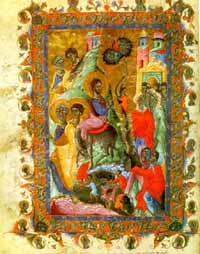
The
Entry into Jerusalem, Lectionary
1286, Cilicia
Exact origin, name of scribe and illuminator unknown
|
|
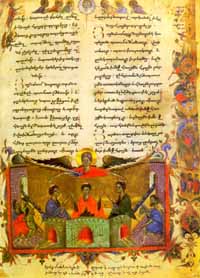
The
Three Hebrews in the Fiery Furnace, Lectionary
1286, Cilicia
Exact origin, name of scribe and illuminator unknown
|
The middle of
the thirteenth century marks the beginning of new creative searches
by the Cilician miniature painters whose achievements at this
time anticipate the forms developed by Byzantine art during the
Third Golden Age.
Cilician artists
of this period sought to break the constraints of medieval canons,
to impart spatial depth to their pictures and to achieve volume
and perspective in figural representation. The trend towards
a realistic depiction of traditional scenes was fully developed
by Toros Roslin.
Unfortunately, just
as with the majority of painters of this time, we know very
little about Roslin's life. According to the colophons of his
manuscripts, he worked at Hromkla between 1250 and 1270 and
was evidently the chief artist of the Patriarch's scriptorium.
He must have been quite a celebrity, for he received commissions
from the capital - from members of the royal family and courtiers.
His popularity was undoubtedly also due to the patronage of
the Catolicos Constantine I, one of the most educated persons
in Cilicia.
One of the most remarkable
manuscripts in the Matenadaran collection signed by Roslin is
the so-called Malatian Gospels (after the town of Malatia) of
1268 (Ms. 10675). It is one of the last, and probably the best
of Roslin's works. It was commissioned by the Catolicos Constantine
I as a gift for Prince Hetoum, son of Leon III.
The art of Toros
Roslin is both serene and magnificent; it combines quiet joyfulness
with light melancholy. The elegant proportions of the figures,
the strictly balanced composition, the ingenuity and variety
of ornamentation, the impeccable taste and moderation in everything
- in the colouring, decoration and choice of motifs inspired
by real life - betray a genuinely classical master of a calibre
which throughout the history of art is only found at the highest
peaks of its development.
The art of Toros
Roslin and of artists belonging to the same generation represented
the classical period in the development of Cilician book illumination.
The ensuing period which began some ten or fifteen years after
the last known work by Roslin was marked by considerable changes
in aesthetic principles, caused by changes in political and
social life. The two last decades of the thirteenth century
were also the end of the Golden Age of Cilicia, followed by
a slow but steady decline. The increasingly frequent raids by
the Egyptian Mamelukes (who in 1292 captured and plundered the
monastery of Hromkla) created an atmosphere of alarm and apprehension
in the country, which could not but tell on the art of this
period.
Following Roslin, the artists of the 1280s
introduce many details prompted by real life into canonical
schemes; like their great predecessor, they seek to convey
the feelings of their characters. But they "out-Roslin Roslin",
as it were, in their pursuit of the true-to-life, and sometimes,
in fact, distort the noble and lofty ideal created by him.
The faces in the miniatures of this period are often crude,
the figures elongated to the point of deformity, particularly
if compared with the almost Hellenistic proportions of Toros
Roslin's figures.
At the same time, their realistic depictions
bring a dynamic and dramatic effect to the miniature, something
Roslinís carefully crafted work sacrificed to achieve a lofty
and otherworldliness to his paintings. These are accessible
scenes from the bible, filled with the horror, joy and human
frailties of life.
|
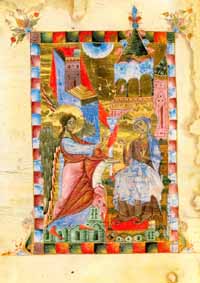
The
Annunciation, The Gospels
1287, Akhner Monastery
Written by Hovhannes, name if illuminator unknown
|
|
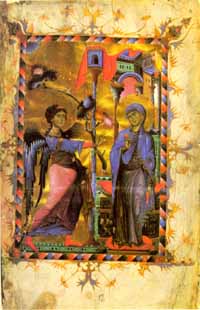
The
Annunciation, The Gospels
Ca. 1280
Origin, names of scribe and illuminator unknown
|
|
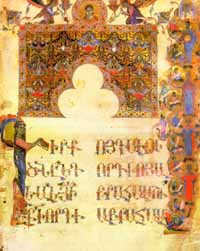
First page of the Gospel of St. Mathew
Ca. 1280
Origin, names of scribe and illuminator unknown
|
The group of manuscripts, which includes the Lectionary of
1286 (Ms. 979), is represented in the Matenadaran by another
example - the Gospels (Ms. 197) written in 1287 at Akhner
by Bishop Hovhannes, brother of King Hetoum I.
The Matenadaran
collection includes another Gospel manuscript dating from
approximately the same period (Ms. 9422). The highly expressive
character of this miniature is marked by it richly hued coloring.
A wide range of pastel tints supports the combination of red,
blue and gold, so typical of Cilician illumination.
The
luxuriously embellished headpieces that mark the Cilician
tradition is apparent in this sample from the 1280 Gospels.
The
original colophon for the 1280 Gospels is unfortunately lost,
but a later, fourteenth-century one survives and presents
a dramatic record of the various mishaps that befell the book
in the monastery of St. John the Forerunner in the town of
Mush (Western Armenia).
In
the middle of the fourteenth century the monks had to hide
their most valuable manuscripts, including the Gospels in
question, to save them from the invaders. When, many years
later, the manuscripts were removed from their secret hiding-place,
it turned out that many of them "had rotten away and were
impossible to read". The monks buried the damaged books, but
fortunately this became known to a certain deacon, Simeon,
who gave orders to have them dug up and hired an expert to
restore them. After restoration the books were returned to
the monastery. Surprisingly enough, the Cilician Gospels which
was among those manuscripts still retains a remarkable freshness
of paint and much of the brilliancy of its rich iridescent
colors.
Another outstanding
Cilician manuscript in the Matenadaran collection is the Gospels
traditionally referred to as the "Gospels by Eight Masters"21
(Ms. 7651).
The character of
its illumination differs from the traditional Armenian book
painting, particularly with regard to the arrangement of illustrations
and ornaments. There are no full-page miniatures; they are
incorporated into the text, forming frieze-like bands - a
method rarely used by Armenian painters and in this case evidently
due to Byzantine influence.
The manuscript
was written in the late thirteenth century by the celebrated
Cilician calligrapher Avetis who apparently worked in the
city of Sis. It was then turned over to a team of painters
for illumination, though for some reason or other the work
was not completed. The subsequent history of the Gospels is
known thanks to a colophon left by its second owner - Stepanos,
bishop of Sebastia - who received the book as a gift from
King Oshin.
The colophon reads:
"I, the worthless Stepanos, bishop of the town of Sebastia,
a lost shepherd and the poor author [of these notes] set forth
to the God-protected country of Cilicia on a pilgrimage to
the relics of St. Gregory. There I met with an honorable reception
and respect from the Patriarch Constantine and King Oshin.
And the devout King Oshin wished to honor me, the worthless
one, with a gift, and I, refusing all things vain, expressed
the wish to possess a book of Gospels.
And on the King's
orders I entered the palace treasury where the holy books
were kept, and when I saw them my heart rejoiced at this book,
which was written in a beautiful cursive hand and adorned
with many-colored pictures, but which was not complete in
its illustration, with some pictures merely outlined, and
still more entirely blank.
|
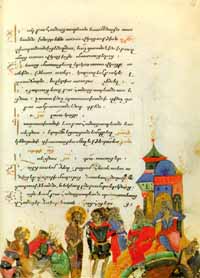
Christ
brought before Caiaphas, The Gospels
1320, Cilicia
Written by Avetis and Stepanos, illuminated by eight
artists, Sarkis Pidzak among them
|
And take the manuscript
I did, with great joy, and started to search for a skilful
artist, and found a devout clergyman Sargis, called Pidzak,
who was experienced in art. And I gave him 1300 drachmae of
my righteous earnings, and he undertook to complete the unfinished
pictures and decorate them with gilding, which he did with
great skill and care, and I, having received the completed
manuscript, rejoiced in my heart. And all this came to pass
in the year 769 [1320] by the Armenian calendar, at a time
of trouble, evil and misfortunes of which I find it unnecessary
to write ... "
Sarkis Pidzak was
the last prominent figure in Cilician book painting. In 1375
Sis, the capital of Cilicia, fell to the armies of the Sultan
of Egypt, which meant the end of Cilician Armenia and, consequently,
the end of Cilician Armenian culture.
|